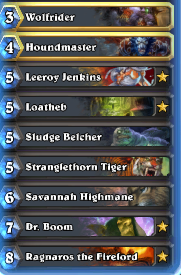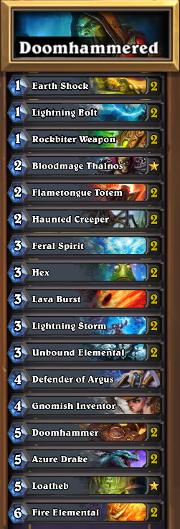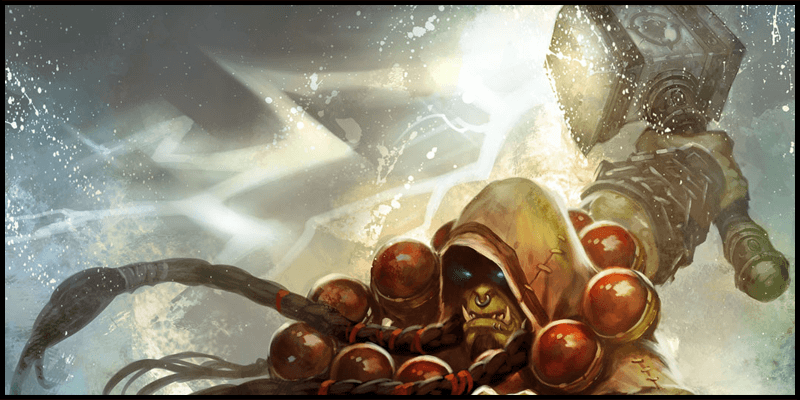Method in the madness?
When it comes to deck-building, I often get the impression that no one really knows what they are doing. There are a seemingly endless number of variables to consider: card quality, curve and synergy to name a few, and tradeoffs always have to be made between them to come up with a thirty card decklist.
Thankfully as a community we seem to have grown beyond the ludicrously hypocritical insult of “netdecking”, because there is a common acknowledgment that decks don’t just pop out fully formed, but instead evolve over countless iterations until something approximating optimisation is achieved. There’s an inevitability about the process, too. Sure, some people will make changes that make a deck less effective, but these won’t be widely adopted for that very reason. Over time, decks will be optimised, by brute force if nothing else.
But this information is useless to the individual. There has to be a formal logic to deckbuilding, some principles we should bear in mind when attempting to innovate a new deck or improve an existing one. While my knowledge is far from exhaustive, I’d like to lay out some guidelines that have proven useful to me in the past.
Aim for Consistency
First, let me explain what this doesn’t mean. This is not flawed logic along the lines of “Patron warrior is a bad deck because sometimes both warsongs are in your bottom five. That’s why I play druid instead.” A deck’s strength is in what percentage of games it wins, not in the nature of its victories or losses.
Now on to what I do mean by consistency. There is a general logic in deckbuilding that 2-ofs of cards are better because this way you maximise the average strength of the cards in your deck. If you have a deck of thirty one-ofs you have, in theory, a lower average card quality than if you were to take the fifteen best cards and run two of them instead.
Players tend to justify running a large amount of 1-of cards because they want to feel prepared for every situation. If someone runs one Wolfrider and one Arcane Golem in their hunter deck, they may well attempt to justify it on these grounds. Yes, Wolfrider might be better in one situation and Arcane Golem in another, but that doesn’t mean running one of each is the correct solution. A good deck-builder should be able to identify which situation comes up the most, and streamline their deck to reflect that. This means evaluating which card is better, and running two of it.
This hunter list, while it looks incredibly fun, is probably something to avoid.


Recognise Diminishing Returns
The last section laid down a general rule that applies to most cards, but deckbuilding is an area where absolute statements can rarely be made. There are a number of situations where the previous rule cannot be applied, and the reason for this is when the second copy of the card has diminishing returns on the first.
When you run two copies of a card in a deck you are changing the dynamic of the deck in two ways. Firstly, you increase the likelihood of seeing that card; secondly, you introduce the possibility of drawing both copies. For a lot of cards, the former quality is desirable, but the latter is not. When you choose to include a second copy of a card in your list, you have to consider this tradeoff, and whether the impact is positive enough to justify including a second copy rather than a different card.
Take a card like Zombie Chow, which is at its best in your opening hand. The first Zombie Chow is fantastic, but the second one is far less useful. This is the reason why it is extremely common to see a singleton copy of Zombie Chow in decklists. This concept can also apply to cards like Big Game Hunter and Acidic Swamp Ooze, specific tech cards that have fewer potential targets once the first copy has been used.
_png/184px-Big_Game_Hunter(73)-version-d8e2e5a857edda4244051e71bb90e6a6.png)
Challenge Assumptions
But as ever when it comes to deck-building, easy rules are extremely hard to come by. There have been plenty of examples of seemingly counter-intuitive deck-building decisions having extreme success. Even cards with extreme diminishing returns can sometimes merit inclusion, simply because the additional chance of drawing them outweighs the potential downside.
Doomhammer is one of the most extreme examples of diminishing returns. In certain metas the card may be extremely useful - perhaps one of the most important cards in your deck. But the card is a significant investment to develop, and takes several turns to fully pay off. You generally cannot afford to play two in one game, so if you run two and draw the second copy then it’s likely to be dead in your hand.
The logic for running only one copy of Doomhammer seemed obvious and intuitive, but this assumption was blown out of the water by Chakki’s famous Double Doomhammer Shaman.

This deck, co-developed by Impact, seems to run counter to the obvious logic. For this list to be superior to single Doomhammer builds, the benefit of the increased likelihood of drawing the first copy would have to outweigh the potential negative of drawing into both Doomhammers. And was it worth it? Well, the deck absolutely dominated SeatStory Cup 2, with Savjz going 10-0 with it to eventually win the event, and Xixo also placing in the top 4 with the list.
Always Think Critically
People have a tendency to act irrationally if they win more games after making changes to a decklist. If, for example, you add a Harrison Jones to your deck, and win all of your next five games, you might be inclined to think that the change brought about the increase in winrate. If, however, you look back, and realise that none of those games were vs weapon classes, or that you never drew the Harrison anyway, then you might be forced to reconsider your conclusion.
If you want to improve in deck-building, you absolutely must adopt this critical mindset. This means you must examine, in every situation where you draw one of the flex-cards in your deck, whether another card would be better in this situation. If so, how much better would it be? Is a card worth running if, even though it is useless a lot of the time, it is potentially game-winning in certain situations? There are no definite answers to these questions, but asking them is crucial.
The best deck-builders always have this mindset, regardless of whether they are winning or losing. It is extremely easy to be blinded by results that could be nothing more than a natural consequence of variance. Remember that correlation does not imply causation, and that improvements can always be made.
Don’t Give Up
If you’re looking to innovate, you should be prepared to fail. A lot. It can take a long time to hammer out viable new decklists, and some archetypes were just never going to be viable (*cough* Dragon Paladin *cough*). But I’ll trot out the old cliché - if you don’t try, you’ll never succeed. And never succeeding doesn’t sound like much fun at all.
I’d like to end by showcasing these two interesting new(ish) lists from Savjz and Eyecelance, just to demonstrate that there’s still room for innovation in the current environment. Warlock and Mage are particularly unexplored.
Liked this article? You can follow Modernleper on:
Twitter - https://twitter.com/modernleper_hs
Twitch - http://www.twitch.tv/modernleper

